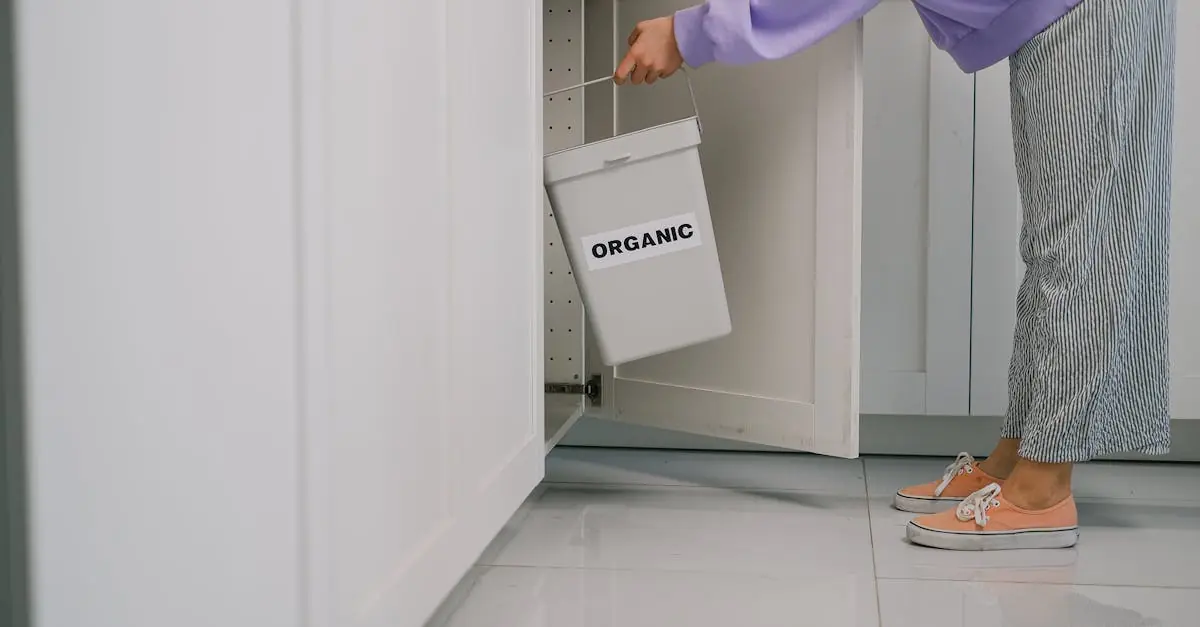Imagine a world where kitchen scraps don’t end up in a landfill but transform into nutrient-rich soil, all thanks to a humble pallet compost bin. This eco-friendly marvel is not just a composting solution; it’s a backyard superhero, ready to rescue waste while saving the planet. Who knew that a few wooden pallets could turn into a composting champion, making Mother Nature proud?
Table of Contents
ToggleOverview of Pallet Compost Bins
Pallet compost bins offer a simple and effective way to manage organic waste. These bins utilize repurposed wooden pallets as a primary structure, promoting sustainability and reducing material waste. Constructing a pallet compost bin typically requires three to four pallets, which create an enclosed space for composting.
When assembled, the pallets form a rectangular or square shape, allowing for proper airflow. Good airflow speeds up the decomposition process, making composting more efficient. Adding a cover can help retain moisture, essential for achieving the right balance within the compost pile.
Benefits of using a pallet compost bin include cost-effectiveness and accessibility. Many individuals can source wooden pallets for free or at a low price, making this an affordable composting option. Additionally, the open design allows users to easily add kitchen scraps, yard waste, and other compostable materials.
In terms of maintenance, turning and aerating the compost frequently accelerates breakdown. Regularly checking moisture levels ensures the composting process remains effective. Compost bins made from pallets can last several years, provided they are treated properly to resist decay.
Visual appeal matters, too. A well-constructed pallet compost bin can complement a garden or yard aesthetic. With some paint or a sealing agent, users can enhance the pallets’ longevity and appearance. Overall, pallet compost bins stand out as a practical choice for those committed to eco-friendly waste management.
Benefits of Using Pallet Compost Bins
Pallet compost bins offer numerous advantages, particularly for eco-conscious gardeners. They promote sustainable practices, effectively minimizing waste and enhancing soil quality.
Environmentally Friendly
Pallet compost bins contribute significantly to environmental conservation. They divert organic waste from landfills, where it contributes to methane emissions, a potent greenhouse gas. Composting transforms kitchen scraps into valuable nutrients, supporting soil health. The use of repurposed wooden pallets also reduces the demand for new materials, conserving resources. Many find that these bins encourage a closed-loop system, enriching gardens while fostering a more sustainable lifestyle. With proper management, these eco-friendly bins enhance biodiversity by attracting beneficial organisms, such as worms and microbes.
Cost-Effective
Building a pallet compost bin proves to be highly economical. Many individuals acquire pallets for little to no cost, significantly lowering initial investment. Unlike commercial compost bins, which can be expensive, pallet structures offer an affordable alternative for waste management. They require minimal tools and materials for construction, making it easy for anyone to get started. Long-term savings occur through reduced waste disposal fees and the ability to produce homemade compost, which enriches soil and reduces reliance on store-bought fertilizers. Overall, the combination of low-cost materials and beneficial outcomes makes pallet compost bins an attractive option for budget-savvy gardeners.
How to Build a Pallet Compost Bin
Building a pallet compost bin involves a few straightforward steps and some essential materials. Creating this eco-friendly space supports sustainable waste management.
Materials Needed
Gather three to four wooden pallets, as they form the base of the bin. Use a sturdy tarp for the roof, which can protect compost from excessive rain. Acquire screws or nails to connect the pallets securely. Find a drill or hammer, both necessary tools for assembly. Incorporate a measuring tape to ensure proper alignment. An optional tarp can enhance aesthetics while providing additional protection. Collect garden gloves too, which can help in managing materials effectively.
Step-by-Step Instructions
Begin by selecting a level spot in the yard or garden for your compost bin. Lay three pallets in a U-shape, leaving one side open for access. Secure the pallets together using screws or nails to ensure stability. Position a fourth pallet vertically, creating a front gate for easy access. Affix a tarp on top to shield the compost from rain while allowing airflow. Fill the bin with organic waste like kitchen scraps and yard waste. Turn the pile every few weeks to enhance decomposition, maintaining optimal moisture and aeration throughout the process.
Best Practices for Maintaining Your Pallet Compost Bin
Maintaining a pallet compost bin efficiently requires attention to several key factors. Proper care ensures optimal decomposition of organic materials.
Ideal Location
Selecting the right spot for the pallet compost bin significantly impacts composting success. Position the bin in a well-drained area that receives partial sunlight. Sunlight helps maintain temperature while moisture drains efficiently. Avoid shaded or overly wet regions to prevent waterlogging. Proximity to the kitchen simplifies access for adding scraps. Ensure the site has adequate airflow to promote decomposition. A flat surface allows easy loading and turning of compost materials. Lastly, consider the bin’s distance from neighbors to avoid unpleasant odors.
Types of Compostable Materials
Understanding what to include in the pallet compost bin enhances the quality of the compost produced. Kitchen scraps like vegetable peels, fruit cores, and coffee grounds serve as excellent nitrogen sources. Yard waste, such as grass clippings, leaves, and small branches, contributes to carbon content. Avoid animal products and processed foods, as they can attract pests. Shredded paper and cardboard can also be added for balance. Mixing green materials with brown materials optimizes the decomposition process. Regularly checking for an appropriate mix ensures efficient composting.
Common Issues and Solutions
Maintaining a pallet compost bin may lead to a few challenges, such as odor issues and pest attraction, but they can be resolved with simple solutions.
Odor Problems
Odors often arise from improper layering or an imbalance of materials. Foul smells indicate that the compost pile is too wet or contains excessive green materials, which are rich in nitrogen. Adjustments can help. Adding brown materials, such as dried leaves or shredded paper, balances the nitrogen content, improving airflow and reducing odors. Turning the compost regularly allows aerobic microbes to thrive, which also helps mitigate smells. Keeping the area around the compost bin clean prevents the buildup of odors from spilled waste.
Pest Control
Pests can be an issue if the compost bin attracts unwanted critters. To deter rodents and insects, one must adopt certain practices. Using a well-fitted, secure lid prevents access from pests. Slicing kitchen scraps into smaller pieces promotes faster decomposition and minimizes the chance of attracting animals. Avoiding animal products and greasy foods reduces the bin’s appeal to scavengers. Implementing a layer of coarse materials, such as wood chips or straw, provides additional protection by creating a physical barrier against pests.
Pallet compost bins offer an innovative and sustainable way to manage organic waste while enriching soil quality. Their cost-effectiveness and accessibility make them an appealing choice for eco-conscious individuals looking to reduce landfill contributions. With minimal tools and effort, anyone can build a functional compost bin that not only serves a practical purpose but also enhances garden aesthetics.
By following best practices for maintenance and composting, individuals can enjoy the benefits of nutrient-rich compost while supporting environmental conservation. Embracing this simple yet effective solution contributes to a healthier planet and fosters a more sustainable lifestyle.








